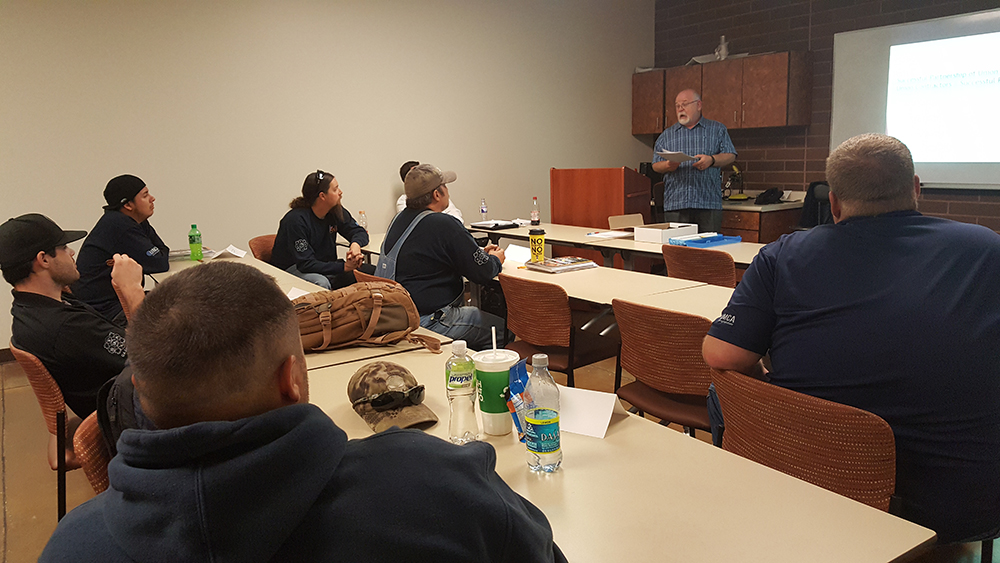UMCA Management Class for Apprentices
UMCA Fosters the Relationship with Field Employees from the First Semester
“The involvement of our contractors at the [Utah Career Center] is something that has always set us apart.”
Jason Warner voiced that perspective during the UMCA Management Class, offered during the UCC’s Heritage, Job Safety & Health class to first semester apprentices. Warner, a journeyman at Commercial Mechanical and future instructor for that class, sat in with Tom Lewis’s Monday night students as they listened to Robert Bergman, UMCA Executive Vice President, and Patrick Lynch, CCI Mechanical contractor and UMCA’s Immediate Past-President, explain the roles and risks of the management side of the mechanical contracting business.
“The labor-management relationship is like a marriage in some ways,” Robert said. “Neither side is going anywhere, and we both need to be working together to be successful.”
 The students’ reasons for taking on an apprenticeship varied as much as their past job histories: They came from the military; from loading boxes at UPS; from previous welding experience in a non-union shop, and from studying pre-law. Some had college experience, others, none.
The students’ reasons for taking on an apprenticeship varied as much as their past job histories: They came from the military; from loading boxes at UPS; from previous welding experience in a non-union shop, and from studying pre-law. Some had college experience, others, none.
They joined the apprentice program for the benefits, for the brotherhood, to learn and be stimulated, to work with their hands, to be part of a quality organization. Their ages ranged as well, from Millenials, to those with an eye on a pension.
UMCA, CBA, and Other Acronyms
Robert reviewed the mechanics of the relationship between management and the union – the Collective Bargaining Agreement (“the bible”), the Drug-Free Workplace program, how and why UMCA works with various government entities, education opportunities for contractors, and the stewardship of the Health & Welfare Fund.
 The ideals of balance and partnership wove throughout the evening’s presentations.
The ideals of balance and partnership wove throughout the evening’s presentations.
“Our goal is to grow market share. With more jobs, comes more work for you,” said Robert. “One of the perceptions out there is that management’s main focus is to push wages down. But we want our work force to be happy where they work. The drawback is, absent a balance between labor and management, you end up being the highest paid craftsman on unemployment.”
The time dedicated in the class to include perspective from management is one of the reasons Warner, and instructor Tom Lewis, cite as the beginning of the working relationship between both sides.
“They [the contractors] recognize this is not an easy trade,” said Tom. “And we have to ask, does our productivity make up for our higher wages? We have to help that productivity.”
“The Career Center is one of the industry’s best kept secrets,” said Robert.
A Taste of Risk
 The meat of the evening began when Patrick Lynch took the floor. As he does with every class he has given this presentation to, he explained the small profit margins a contractor plays with, and the risks involved that can absorb it quickly.
The meat of the evening began when Patrick Lynch took the floor. As he does with every class he has given this presentation to, he explained the small profit margins a contractor plays with, and the risks involved that can absorb it quickly.
“I cannot expect you guys to be productive unless I’ve done my part,” said Patrick. He went on to explain that a contractor’s part includes paying for benefits, pensions, fees and taxes above each workers hourly wage. Providing tools and equipment to do the work is also mandatory, as are the materials.
And all of these items are paid with the money that at first glance may seem like a lavish profit margin.
Students were then paired up to work on creating their own estimates for a hypothetical job. Armed only with a sketched plan, costs of labor, rentals, and materials, groups had to estimate costs and bid on the job. After an hour of work (some groups even working through their scheduled break), the final numbers were compared. Total bids ranged from $2,000 to $20,000.
Apprentice Bids on UMCA’s Estimator Project
|
TEAM 1 |
TEAM 2 | TEAM 3 | TEAM 4 |
TEAM 5 |
|
| TOTAL BID | $20,000 | $6,833 | $19,000 | $9,500 | $2,038 |
| MATERIALS | $1,602.75 | $1,510.02 | $1,664.00 | $1,288.42 | $909.59 |
| LABOR | $6,310.00 | $4,027.00 | $6,000.00 | $5,753.00 | $958.54 |
| RENTAL EQUIPMENT | $900.00 | $300.00 | $850.00 | $1,200.00 | $170.00 |
| OVERHEAD | $4,000.00 | $375.00 | $500.00 | $412.00 | $0 |
| PROFIT | $7,187.25 | $621.00 | $8,500.00 | $8.24.00 | $0 |
“There is no right answer,” said Patrick, who walked them through potential pitfalls with different numbers. If labor costs rose significantly more than estimated, the lean bid might not come out even, and the contractor ends up losing money on the project. On the other hand, if materials costs were overestimated, those higher bids could see more profit than the expected. Even the bid that calculates all parts accurately could be a loser.
“The profit [from mechanical contracting] can be good and you can make a decent living off of it, and it can also evaporate quickly.”
– Patrick Lynch
One or two projects with a larger profit margin are what a contract needs every year to stay in business. They cover the sometimes 120-day gap between invoicing and payments from general contractors; they cover the time and money spent on bids that don’t get awarded a contract; they cover schedule changes that can push labor costs up, or even cover the interest on the lines of credit contractors take out to make payroll every week.
Being a contractor and managing all those moving parts, “is an art form,” said Patrick. “The profit can be good and you can make a decent living off of it, and it can also evaporate quickly.”
“Contractors need to have the gambling spirit, because you only get maybe 40 percent of the jobs you bid on,” he added.
![]() For the rest of the semester, the class of apprentices will return Monday nights, after working a full day on the job, and learn more about union history, brotherhood and practices. But for one night, they heard both their union instructors, and contractor management tell a story on building something bigger than either side could do alone.
For the rest of the semester, the class of apprentices will return Monday nights, after working a full day on the job, and learn more about union history, brotherhood and practices. But for one night, they heard both their union instructors, and contractor management tell a story on building something bigger than either side could do alone.



